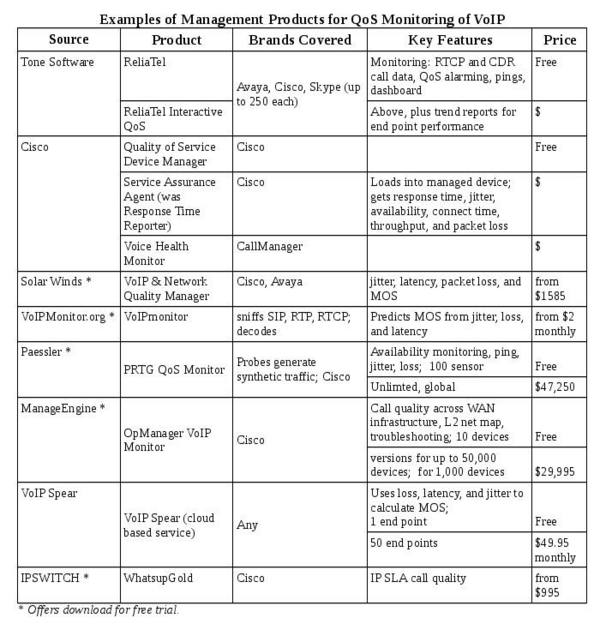When VoIP Fails 'Breaking Up' is Hard to Undo
There was a time when troubleshooting a voice problem was tedious but well-defined. For an outage or "noise on the line" there were standard procedures for test and repair. The technician needed an analog "butt set" or resistance meter, seldom more. When a Voice over IP connection is 'breaking up,' what's a tech to do, just call your network administrator?
Start Right
There's seldom an easy answer for a VoIP sound quality problem. Here an ounce of prevention is worth a lot more than a pound of troubleshooting. In short, before putting VoIP on a network make sure that network can carry voice traffic properly.
Adequate Bandwidth. Local area networks running at 100 Mbit/s or a gigabit can carry dozens of voice calls. Even a 10 Mbit/s Ethernet is ample capacity for a small office. Access speed to the wide area network may present a bottleneck, particularly when shared with data-intensive applications.
Top Priority. A high quality VoIP connection depends strongly on low latency and little if any packet loss. Short voice packets get delayed if queued behind multiple long data packets. Most routers can prioritize packets based on criteria like subnet, vLAN, protocol, and application. Best practice is to apply the top priority to voice for minimum delay through all your internal networks.
Minimum Packet Loss. Voice packets sent quickly also face less chance of being discarded during congestion. Lost packets are a common cause of the 'breaking up' effect, starting at about 1% loss ratio. Missing information is not replaced by a retransmission because there is no time, which is why voice almost always travels on UDP and not TCP (which could retransmit a missing packet, but too late to be of use). So we fall back to the Human Understanding Helper protocol (Huh?).
When voice is sent to the WAN as IP packets, priority is particularly important at the gateway router where the LAN speed drops to a much lower rate. If your carrier supports class of service markings, and your router is capable, mark voice packets for better service than data (such as email and web browsing) for the best end-to-end quality of service.
Watch Closely
Network monitoring for voice quality can spot problems before they become user complaints. Several software products pull together information from routers, hardware probes, software agents, and applications on servers to estimate the user's perception of voice quality. There are standards to translate empirical measures (latency and packet loss) into approximate Mean Opinion Scores (MOS, the judgment of trained listeners).
When the quality measure falls below a threshold the alarm sounds and statistics point to possible causes. Don't have a dedicated voice quality monitor? Then the hunt gets harder.
Within an enterprise, the statistics on utilization, for example, and logs of routers can point to sources of latency and places where packets are dropped. Many vendors offer monitoring software to simplify the job of keeping VoIP quality high. The following table describes some examples.
Other names in management and monitoring for enterprise VoIP include Arbor Networks, Agilent Technologies, Dorado Software, eG Innovations, Fluke Networks, H-P, IBM, InfoVista, NetIQ, Opnet, Riverbed Technology, Savvius, SevOne, Viavi Solutions, and Zenoss. Carrier monitoring is a market segment which overlaps enterprises but isn't identical.
When you're in a bind, there's always WireShark, the very sophisticated sniffer that can show what the traffic is doing (filtered for VoIP if desired) and decode most content.
All these monitoring tools typically fit the needs of network administrators and business managers. Alcatel-Lucent has an approach to push the first level of troubleshooting out to the consumer for self service. The Motive Customer Experience Manager, on a smart phone, detects and lists Wi-Fi access points and cell towers in the area, recommends radio channels to use, and alerts the user to problems like interference.
Every generation is comfortable with the latest technology. With 'friendlier' front ends on tools that monitor and manage the network, there will be less need to "Call your Network Administrator." We have seen the new NA, and he is us.
Editor's Note: Mr. Flanagan's analysis was originally posted to subscribers of his Views Letters on VoIP, www.viewsletters.com. He can be reached for further information at www.Flanagan-Consulting.com.














Trending Discussions
- If you would like to see the other articles in the blog post of the "Top Ten VoIP Articles of All Ti... Steven Taylor, Webtorials on "Is VoIP Secure? YOU Make the Call":
- Great job I followed since the begining thanks... Eduardo Pérez Telesystems SpA on "The 2018 Guide to WAN Architecture and Design - Executive Summary":
- Thanks to Marjorie at RingCentral for reminding me that this paper existed. Looking forward to your... Steven Taylor, Webtorials on "Is VoIP Secure? YOU Make the Call":
- looking at WAN re-engineering projects... Sunny on "The 2018 Guide to WAN Architecture and Design - Part 2: Key Considerations when Choosing new WAN and Branch Office Solutions":
- Hi Richard. We appreciate your feedback. Jim Metzler always provides excellent analysis on the ever-... Nancy Leonard, Webtorials on "The 2017 State-of-the-WAN Report":
- Interesting reading... Richard Fausey, Plow, LLC on "The 2017 State-of-the-WAN Report":
- I needed this document. Thank you.... AO NII Mashtab on "The 2017 Guide to WAN Architecture and Design - Executive Summary":
- I look forward to reviewing more info on this topic.
... trevor evans - fox group on "2017 Workplace Productivity and Communications Technology Report":
- I would like access to your "2017 Workplace Productivity and Communications Technology Report"
Than... Paul Zielie, Harman Professional Solutions on "2017 Workplace Productivity and Communications Technology Report":
- I'm Telecommunications Engineer at PETROBRAS S.A. and i have overall interest about WAN. ... JOSE CEREZO, PETROBRAS S.A. on "The 2017 Guide to WAN Architecture and Design - Part 1: State of the WAN":
See more discussions...